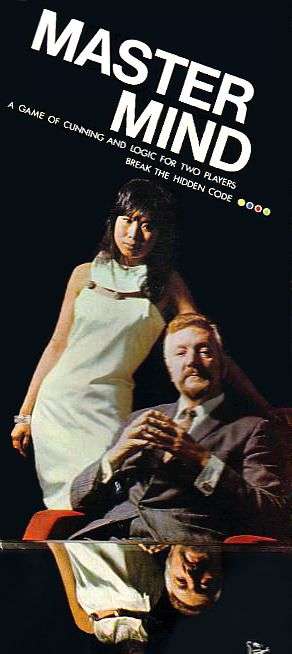Mastermind (game)

Mastermind is a code-breaking game for two players. The modern game with a plastic board and pegs was invented in 1970 by Mordecai Meirowitz, an Israeli telecommunications expert, but the game resembles an earlier pencil and paper game called Bulls & Cows that may date back a century or more.
The game is played using:
- A decoding board, with a shield at one end covering a row of four large holes, and twelve (or ten, or eight) additional rows containing four large holes next to a set of four small holes;
- Code pegs of six (or more) different colors, with round heads, which will be placed in the large holes on the board; and
- Key pegs, some colored (often black), some white, which are flat-headed and smaller than the code pegs; they will be placed in the small holes on the board.
The two players decide in advance how many games they will play, which must be an even number. One player becomes the codemaker, the other the codebreaker. The codemaker chooses a pattern of four code pegs. Duplicates are allowed, so the player could even choose four code pegs of the same color. The chosen pattern is placed in the four holes covered by the shield, visible to the codemaker but not to the codebreaker.
The codebreaker tries to guess the pattern, in both order and color, within twelve (or ten, or eight) turns. Each guess is made by placing a row of code pegs on the decoding board. Once placed, the codemaker provides feedback by placing from zero to four key pegs in the small holes of the row with the guess. A colored (often black) key peg is placed for each code peg from the guess which is correct in both color and position. A white peg indicates the existence of a correct color peg placed in the wrong position.
If there are duplicate colors in the guess, they cannot all be awarded a key peg unless they correspond to the same number of duplicate colors in the hidden code. For example, if the hidden code is white-white-black-black and the player guesses white-white-white-black, the codemaker will award two colored pegs for the two correct whites, nothing for the third white as there is not a third white in the code, and a colored peg for the black. No indication is given of the fact that the code also includes a second black.
Once feedback is provided, another guess is made; guesses and feedback continue to alternate until either the codebreaker guesses correctly, or twelve (or ten, or eight) incorrect guesses are made.
The codemaker gets one point for each guess a codebreaker makes. An extra point is earned by the codemaker if the codebreaker doesn't guess the pattern exactly in the last guess. (An alternative is to score based on the number of colored key pegs placed.) The winner is the one who has the most points after the agreed-upon number of games are played.
Much like a Rubik's Cube, the vanilla game (four-peg codes, six colors) appears difficult, but can be easily beaten by employing some simple, easy-to-remember tricks.
The game was originally produced with box-art that seemed to suggest that "masterminds" would pose like James Bond villains and have Dragon Lady girlfriends.
This page has no trope entries and desperately needs them. You can help this wiki by adding those trope entries.